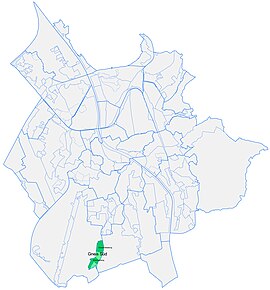Gneiss south
The term gneiss south of town planning of the magistrate Salzburg are part of the spatially separated by the Morzgerwald, after the Second World War, especially in the wake of the settlement grown refugees land cores Eichethofsiedlung and Birkensiedlung together, both in the space around the Almkanal west of Berchtesgadnerstraße and south of the Gneiss district. Along the Almkanal with its impressive pollarded willows on the Almkanal runs a footpath and cycle path which, as a recreational axis, connects the Gneiss South settlement area with the old town of Salzburg and the Mönchsberg. Before the construction, there were agriculturally unproductive littered moor meadows on the edge of the Leopoldskron moor, whose biodiversity was previously famous. There were extensive populations of the Siberian iris (Iris sibirica), but also the swamp gladiolus (Gladiolus palustris) and various species of fen orchids often grew here.
The forest in the west was formerly known as "Grödiger Eichet", as the moor edge forest there was shaped by oak in centuries past, as was the oak forest in the area of today's Eichetsiedlung (next to the Kendlersiedlung in the municipal area of Wals-Siezenheim). The forest in the south of the Eichethofsiedlung used to be called Almholz, the oaks that grew there supplied u. a. the slaughtering for the Almkanal.

